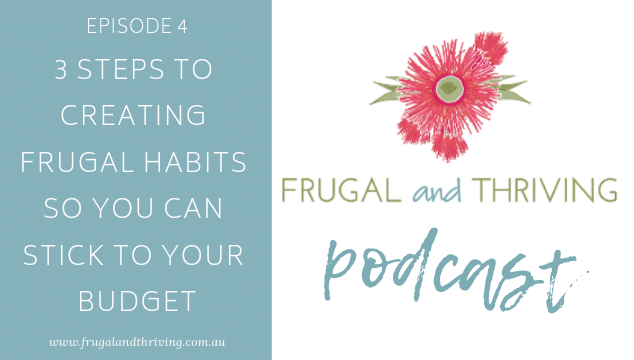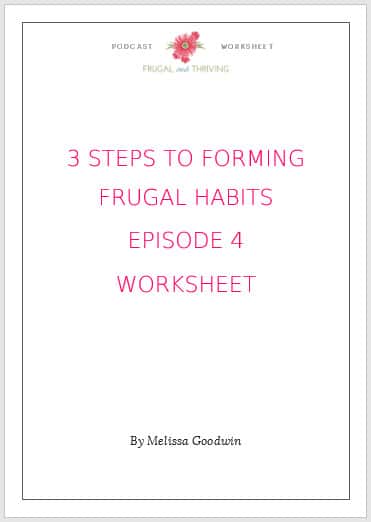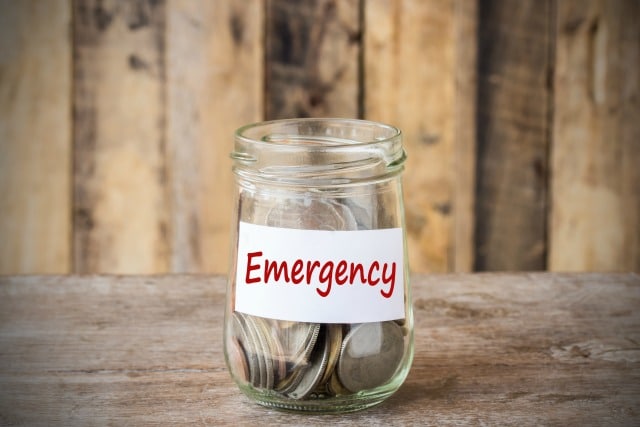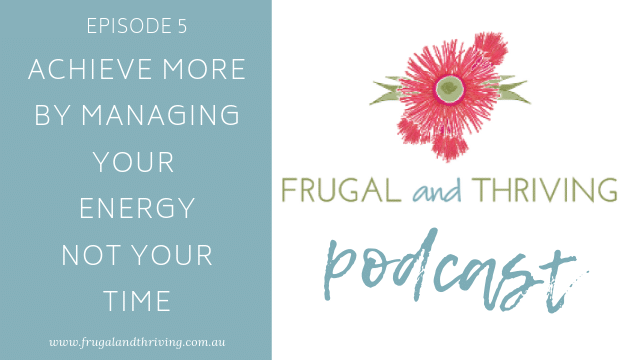3 Steps to Creating Money Habits That Help You Save
This website may earn commissions from purchases made through links in this post.
The key to sticking to your budget is to create good money habits. Master these habits, and the savings follow automatically.

In today’s episode, I’m going to be diving deeper into budgeting, specifically, how to stick to your budget.
You can listen to the podcast below or continue reading the article/transcript. And don’t forget, you can also subscribe in your favourite podcast app.
Disclaimer: This is general information only. In this blog, I share my savings and budget planning and what works for us. You should always consult a qualified financial expert when making money decisions to tailor plans to suit your circumstances.
In the last episode, I shared the three essential strategies for creating a more effective budget. I hope you’ve had a chance to listen and to try these strategies out for yourself.
In that episode, I talked about the importance of paying yourself first so that you’re guaranteed to save a portion of your income each and every week.
But in order to not blow your savings, or
If you’ve ever written a budget and then found it really hard to stick to then stay tuned, I’m going to share the three-step plan that I use to stick to a budget.
Years ago when I first started budgeting I created this really complicated spreadsheet budget, because at the time I was working as an accountant and I had a little bit of spreadsheet love.
Now as someone who created budgets for a living, you would think that I would totally nail my own budget, right?
But I didn’t.
Every week, when I compared our actual spending to our budget, we were always over and we were not saving as much money as we knew we could.
What was the problem?
I think it comes down to two things:
- The budgeting system itself. And I talked about this in the last episode: about switching our budget around so that savings come first.
- Sticking to our spending plan comes down to our behaviours and habits, not the numbers on the spreadsheet.
Good financial habits are more important than a budget and it’s our frugal habits that I’ll be talking about in this episode.
Why Good Money Habits Trump a Budget
Just say I decided to cut out buying lunch at work to save money. And I’ve written a big fat zero on the budget for eating out.
I start the week out strong: on Monday, Tuesday and Wednesday I nail my new lunch resolution.
But then comes Thursday. I’m getting tired. I forgot to shop, so the fridge is empty. By lunchtime I’m hungry.
What do I do?
I buy lunch, of course. And Friday, well what the heck, I’ll get back on track next week, right?
Now, what happens when we go back and review our budget?
If you’re like me, the inner critic, that voice in our head, tells us how we’re no good at budgeting and we’ll NEVER stick to our budget. So why try?
The critic is wrong. There is a way to stick to our budget. And it’s NOT guilting ourselves to do better. The answer is creating an action plan for success.
Three Steps to Good Money Saving Habits
In my work lunch example, I bought lunch on Thursday not because I’m a failure at discipline, I bought lunch because I hadn’t planned an alternative and had I no other option but to fall back on old habits.
The key then to sticking to your budget is creating positive habits.
When we create a budget, we make the mistake of cutting out stuff from our lives. We’re going to cut out work lunches, and we’re going to cut out takeaway and we’re going to cut out clothes shopping and we’re going to cut, cut, cut.
And then it feels like life sucks and we’re living a life of deprivation and when we stumble, because we will when we don’t have an alternate plan, we beat ourselves up for failure.
This is a crazy way of budgeting but it’s the way most of us budget.
We swing from good intentions to berating ourselves, to stuffing the budget in the drawer in defeat then back to good intentions. This is not a productive cycle but there’s a way to break it.
Instead of cutting things from our lives we need to add new routines.
Whoa, you might be thinking, life is super busy and hectic as it is, and you want me to add new routines. Are you kidding?
I hear you, I feel the same.
The truth is, creating good spending habits does take a little extra mental power. You’re switching from operating on auto-pilot to being more intentional about your routines. This can definitely take a little extra time and energy.
For a little bit.
Until these NEW spending patterns become habits. Until they become your new auto-pilot. This brings me to the three-step plan for sticking to your budget.
- Acceptance
- Intentional action planning
- Forming Frugal Habits
Creating new auto-pilots (or habits) that save you money will help you to stick to your budget, automatically and without a lot of effort.
You’re already busy, so just focus on one habit at a time. You will be more successful if you tackle one expense at a time and it will take less energy.
And I have a worksheet in the show notes to help with this process. So click the link in the show notes and download your copy.
Now you know the three-step plan: acceptance, planning and habits, here’s how to put them into action.
Three steps to sticking to your budget
Acceptance seems like a really strange place to start but it is such a powerful strategy and it’s absolutely fundamental to creating better money habits. So it’s super important to get a handle on this.
Here’s what I mean by acceptance.
Key #1: Accepting Barriers
One of my biggest budget fails comes to takeaway food. We used to draw up a budget, CUT takeaway out, resolving to never buy takeaway.
All good intentions.
And then… Friday evening would come. I would be tired and I really really didn’t want to cook.
Being tired was a BARRIER to sticking to our budget.
Now I could fight this barrier or I could accept it and for a long
That voice inside my head that we all have would be like: you should get your lazy butt off the couch and go and cook. Stop making excuses. You should just suck it up and get on with it. You should…”
So, sometimes I would win that fight, I would get my butt off the couch and cook dinner.
But more often than not I wouldn’t and we would blow the budget on takeaway and feel bad about it afterwards.
The alternative is accepting our barriers and working with them.
In this case, acceptance for me was acknowledging the tiredness I feel on Friday nights and accepting that I’m not going to want to cook.
Acceptance isn’t giving in. You’re not taking off the gloves and stepping out of the ring. What you ARE doing is realising that the boxing moves you’re using aren’t working so you’re going to try a sneaky head butt and a kick to the knee.
In other words, it’s creative problem-solving within the constraints of reality.
Acceptance is about acknowledging the way things are and then finding ways to work with the reality of our everyday life.
Once I acknowledged and accepted that I am probably not going to cook dinner on Friday, I could come up with ways to work around it.
I had a few options: I could have made sure there were leftovers to reheat. I could serve breakfast for dinner or have toasted sandwiches or frozen pies or store-bought veggie burgers. Incidentally, fish wraps are our actual go-to meal Friday night meal.
Acceptance solved the problem of what to eat on Friday nights without all the negative self-talk and guilt. I stopped fighting and I still won. And sticking to the budget followed automatically.
You can apply this idea to any area of your budget.
Just say you enjoy buying magazines or new clothes. Instead of cutting, cutting, cutting and feeling deprived, acceptance means looking for alternate solutions that create a win-win for both our happiness and our budget.
When we get the concept of acceptance and working with reality rather than fighting it, it is so empowering. Which is why it’s the first step to forming better money-saving habits.
Acknowledging our barriers is an essential gateway to problem-solving. It’s not giving up, it’s working with reality to find solutions. This brings us to step #2: finding those working solutions and creating an action plan for success.
Key #2: Strategic Action Planning
A strategic action plan sounds a little formal and intimidating, but it is simply a plan for making your budget a reality.
I’m going to use the example of work lunches. Successfully not buying lunch at work means making sure you take lunch every day, right? That makes sense. Without lunch you get hungry and so buying it is inevitable.
So, your action plan is how you make sure you ARE taking lunch to work each day.
Your exact plan will depend on your circumstances. You will need to consider how the what, when, where and how will fit within your reality.
Here is a general outline for creating an action plan. And remember, there’s a worksheet in the show notes to help you with this. Choose just one expense at a time to work on to make life easier.
- Brainstorm some working solutions and choose one to try.
- What resources will you need to complete your action plan?
- What baby steps do you need to take? Write them down.
- When and where will you action each step?
Let’s look at how this might work with lunches.
First, brainstorm working solutions.
Maybe you could prepare a week’s worth of lunches on Sunday.
Or maybe you can save leftovers from each dinner to take to work.
Maybe you buy the ingredients for lunch and assemble them at work.
Or maybe you can wake up 20 minutes earlier every morning to make lunch then.
Choose ONE option that works for you and write down exactly WHAT lunch you will make.
Just say you decide to buy ingredients and assemble lunch at work. You might decide that this week’s lunches will be crackers with avocado, tuna, tomato and ricotta.
Next, write down what resources you’ll need. You’ll need to buy the ingredients, so write those down on your shopping list. Do you need containers to take lunch in? Is there a fridge at work or will you need an ice brick? These are things to consider when thinking about resources.
Then write your action plan. What specific baby steps do you need to make sure you always have lunch at work.
WHEN will you buy your lunch ingredients. WHERE will you shop. WHEN will you prepare your lunches. WHAT will you pack your lunches in and when?
Creating routines is a powerful way to get things done consistently with minimal mental effort. And success comes when you schedule your steps on your calendar rather than just putting them on a vague to-do list.
Now, this might feel like a lot of work for something that seems pretty straightforward, but when we are creating new habits, ones we want to keep, we have to make them explicit before they become automatic.
Which brings us nicely to step 3: cementing good money habits.
Key #3: Frugal Habits
Successful budgeting relies on frugal habits.
If you want to reduce your electricity bill, you need to get into the HABIT of turning out the lights when you leave a room.
To reduce your grocery bill, you need to get into the HABIT of meal planning.
If you want to reduce your takeaway spending, you need to get into the HABIT of cooking.
And so on.
When we focus on the habits and not the budget, the savings follow automatically. Or as BJ Fogg puts it, “design for the behaviours that lead to the outcomes and the outcomes will follow.”
Habits are powerful because once established, they are automatic. They take the willpower and discipline out of sticking with your budget and if you’ve listened to the previous podcast, you’ll know I’m all about not relying on willpower.
But, you do need to take intentional action to solidify a new frugal habit. Which is what our action plan in step 2 is all about.
There are two sides to the habit coin: one side is breaking bad habits and the other side is forming new “good” habits or habits that further your goals.
A habit can be broken down into three parts:
- The trigger
- The Routine
- The Reward
You’ve already worked out your new routine or intentional action plan in step 2. Identifying the trigger and reward will help you turn this action plan into a frugal habit that saves you time and mental energy as well as money.
Here’s an example of a spending habit and how we can turn it around into a savings habit.
Converting Spending Habits to Saving Habits
Just say whenever you have a stressful day at work, you go online to chill out. While you’re there, you find yourself browsing stores and buying new clothes. And it makes you feel good about yourself and you feel less stressed.
The trigger in this scenario is work stress. The routine is online shopping. And the reward is the purchase that leads to feeling good and thus reducing the stress.
If you want to stop impulse buying clothes (the routine), then first you need to understand your trigger or triggers and the rewards you get from shopping.
For example, when the trigger is work stress, the reward is de-stressing. You can’t always eliminate your trigger (although if you can, then that’s the best place to start), but you can usually find other routines to get the same reward. So when you’re stressed, you might try a routine of listening to music or having a bath to create the same calming effect.
This comes back to acceptance. Being aware of our triggers, accepting them and problem solving a work around.
Check out this article for more information about identifying triggers.
So how does the trigger, routine, reward loop work when we want to create a NEW habit?
Creating Good Money Habits
You worked out a routine from step 2. You’ve looked at what your routine will be, when you will do your savings routine, and what resources you’ll need.
The next step is to find a trigger, something you already do that you can attach the first step of your action plan to.
When I do X, then I will do Y.
For example, if you already meal plan, that can be your trigger to remind you to plan for lunches as well.
When I meal plan (trigger) then I will also plan my lunches (routine).
Or, If you want to take leftovers to work, your trigger might be cooking dinner the night before.
When I cook dinner (trigger), then I will dish out leftovers for tomorrow (routine).
Trigger, routine, reward.
Let’s talk about rewards.
The reward part is super important as well. Identifying the rewards you get from your old habit – and this might take some trial and error – will make or break your new habit.
For our work lunch example, possible rewards from buying lunch might include:
- Convenience. Being able to sleep in.
- Getting out of the office to stretch your legs and having a break from work.
- The enjoyment you get from the food that you buy. If that’s the reward, then replacing a burger with tuna cruskits might not cut it.
- Another reward might be socialising, eating with colleagues or chatting to the barista.
When you plan your new frugal habit, you need to take into account the reward you get from your old habit so that you still get that reward with the new routine. Otherwise, you won’t stick with it.
So if your biggest reward is getting out of the office for a change of scenery when you buy lunch, then leftovers at your desk won’t be a habit you’ll stick with. Part of your new routine will have to include leaving the office to eat to get the same reward and make the new habit stick.
That’s the three-step plan to creating frugal habits, which will help you to stick to your budget. It takes a little effort at the start but the rewards of automating frugal habits last a lifetime.
Recap
So to recap this episode: in order to stick to a budget, you need to do three things:
- Identify and accept the barriers to sticking with your budget. This way we can work around them to create win-win solutions.
- Create an action plan for your alternate solution. Instead of focusing on the negative action, cutting expenses, focus on the postive action, things that you CAN do, not things that you won’t.
- Turn this action plan into a habit that will eventually run on auto-pilot. To start with, you need to be intentional about your actions and conscious of your triggers and rewards.
Eventually, this new action will become a habit. And sticking with your budget will also be automatic and easy.
In his book, Atomic Habits, James Clear says that life today is the sum of your habits. Your savings aren’t about how well you write a budget, they are the sum of better money habits. Nail the habits and your budget will take care
Consistent action is the secret sauce to success, but life is busy, hectic and exhausting, how do you add new routines on top of all that.
In the next episode, that’s what I’m going to cover… and the solution is usually NOT better time management. It’s something in my experience is even more important than being organised or being more productive.
Resources Mentioned in This Episode

- Frugal Habits Worksheet
- How to recognise your triggers
- Much of the trigger, reward, routine loop comes from Charle’s Duhigg’s book The Power of Habit: Why we do what we do and how to change.
- Atomic Habits, James Clear
Subscribe to the Podcast
Get the latest episodes when they go live. Subscribe in your favourite podcast app or using the buttons below:









Best, most down to earth and practical guide to frugal living in Australia I have found anywhere. I unexpectedly found myself having to live on the age pension and your blog has been inspirational. Thanks Melissa
Mardi
Thanks Mardi :) I hope things are going well for you.